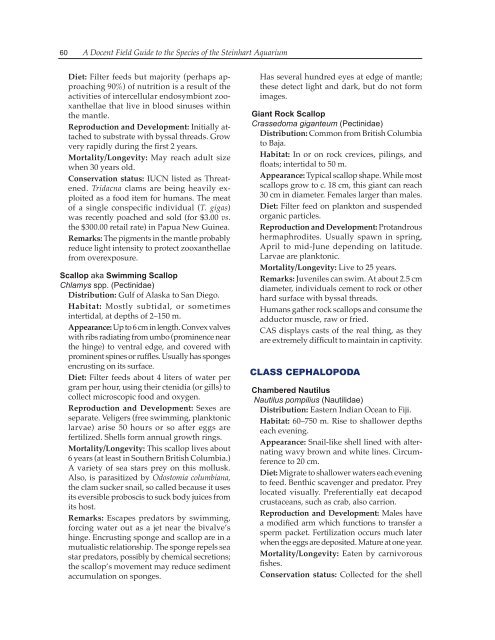THE STEINHART AQUARIUM - Gulf of Guinea Science ...
THE STEINHART AQUARIUM - Gulf of Guinea Science ...
THE STEINHART AQUARIUM - Gulf of Guinea Science ...
Create successful ePaper yourself
Turn your PDF publications into a flip-book with our unique Google optimized e-Paper software.
60 A Docent Field Guide to the Species <strong>of</strong> the Steinhart Aquarium<br />
Diet: Filter feeds but majority (perhaps approaching<br />
90%) <strong>of</strong> nutrition is a result <strong>of</strong> the<br />
activities <strong>of</strong> intercellular endosymbiont zooxanthellae<br />
that live in blood sinuses within<br />
the mantle.<br />
Reproduction and Development: Initially attached<br />
to substrate with byssal threads. Grow<br />
very rapidly during the first 2 years.<br />
Mortality/Longevity: May reach adult size<br />
when 30 years old.<br />
Conservation status: IUCN listed as Threatened.<br />
Tridacna clams are being heavily exploited<br />
as a food item for humans. The meat<br />
<strong>of</strong> a single conspecific individual (T. gigas)<br />
was recently poached and sold (for $3.00 vs.<br />
the $300.00 retail rate) in Papua New <strong>Guinea</strong>.<br />
Remarks: The pigments in the mantle probably<br />
reduce light intensity to protect zooxanthellae<br />
from overexposure.<br />
Scallop aka Swimming Scallop<br />
Chlamys spp. (Pectinidae)<br />
Distribution: <strong>Gulf</strong> <strong>of</strong> Alaska to San Diego.<br />
Habitat: Mostly subtidal, or sometimes<br />
intertidal, at depths <strong>of</strong> 2–150 m.<br />
Appearance: Up to 6 cm in length. Convex valves<br />
with ribs radiating from umbo (prominence near<br />
the hinge) to ventral edge, and covered with<br />
prominent spines or ruffles. Usually has sponges<br />
encrusting on its surface.<br />
Diet: Filter feeds about 4 liters <strong>of</strong> water per<br />
gram per hour, using their ctenidia (or gills) to<br />
collect microscopic food and oxygen.<br />
Reproduction and Development: Sexes are<br />
separate. Veligers (free swimming, planktonic<br />
larvae) arise 50 hours or so after eggs are<br />
fertilized. Shells form annual growth rings.<br />
Mortality/Longevity: This scallop lives about<br />
6 years (at least in Southern British Columbia.)<br />
A variety <strong>of</strong> sea stars prey on this mollusk.<br />
Also, is parasitized by Odostomia columbiana,<br />
the clam sucker snail, so called because it uses<br />
its eversible proboscis to suck body juices from<br />
its host.<br />
Remarks: Escapes predators by swimming,<br />
forcing water out as a jet near the bivalve’s<br />
hinge. Encrusting sponge and scallop are in a<br />
mutualistic relationship. The sponge repels sea<br />
star predators, possibly by chemical secretions;<br />
the scallop’s movement may reduce sediment<br />
accumulation on sponges.<br />
Has several hundred eyes at edge <strong>of</strong> mantle;<br />
these detect light and dark, but do not form<br />
images.<br />
Giant Rock Scallop<br />
Crassedoma giganteum (Pectinidae)<br />
Distribution: Common from British Columbia<br />
to Baja.<br />
Habitat: In or on rock crevices, pilings, and<br />
floats; intertidal to 50 m.<br />
Appearance: Typical scallop shape. While most<br />
scallops grow to c. 18 cm, this giant can reach<br />
30 cm in diameter. Females larger than males.<br />
Diet: Filter feed on plankton and suspended<br />
organic particles.<br />
Reproduction and Development: Protandrous<br />
hermaphrodites. Usually spawn in spring,<br />
April to mid-June depending on latitude.<br />
Larvae are planktonic.<br />
Mortality/Longevity: Live to 25 years.<br />
Remarks: Juveniles can swim. At about 2.5 cm<br />
diameter, individuals cement to rock or other<br />
hard surface with byssal threads.<br />
Humans gather rock scallops and consume the<br />
adductor muscle, raw or fried.<br />
CAS displays casts <strong>of</strong> the real thing, as they<br />
are extremely difficult to maintain in captivity.<br />
CLASS CEPHALOPODA<br />
Chambered Nautilus<br />
Nautilus pompilius (Nautilidae)<br />
Distribution: Eastern Indian Ocean to Fiji.<br />
Habitat: 60–750 m. Rise to shallower depths<br />
each evening.<br />
Appearance: Snail-like shell lined with alternating<br />
wavy brown and white lines. Circumference<br />
to 20 cm.<br />
Diet: Migrate to shallower waters each evening<br />
to feed. Benthic scavenger and predator. Prey<br />
located visually. Preferentially eat decapod<br />
crustaceans, such as crab, also carrion.<br />
Reproduction and Development: Males have<br />
a modified arm which functions to transfer a<br />
sperm packet. Fertilization occurs much later<br />
when the eggs are deposited. Mature at one year.<br />
Mortality/Longevity: Eaten by carnivorous<br />
fishes.<br />
Conservation status: Collected for the shell


